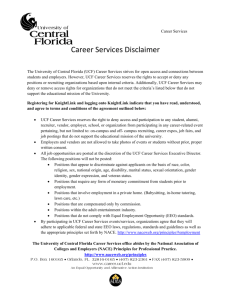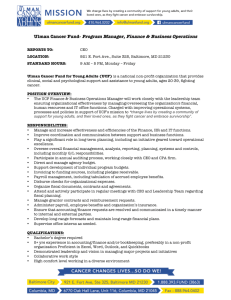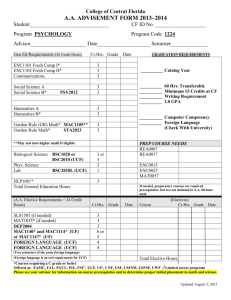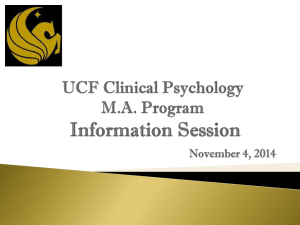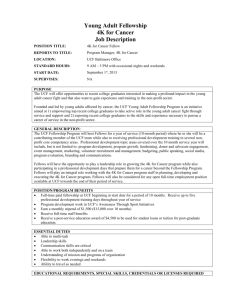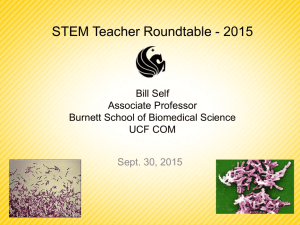Presented by: Dena Ford, NCC, LMHC
advertisement
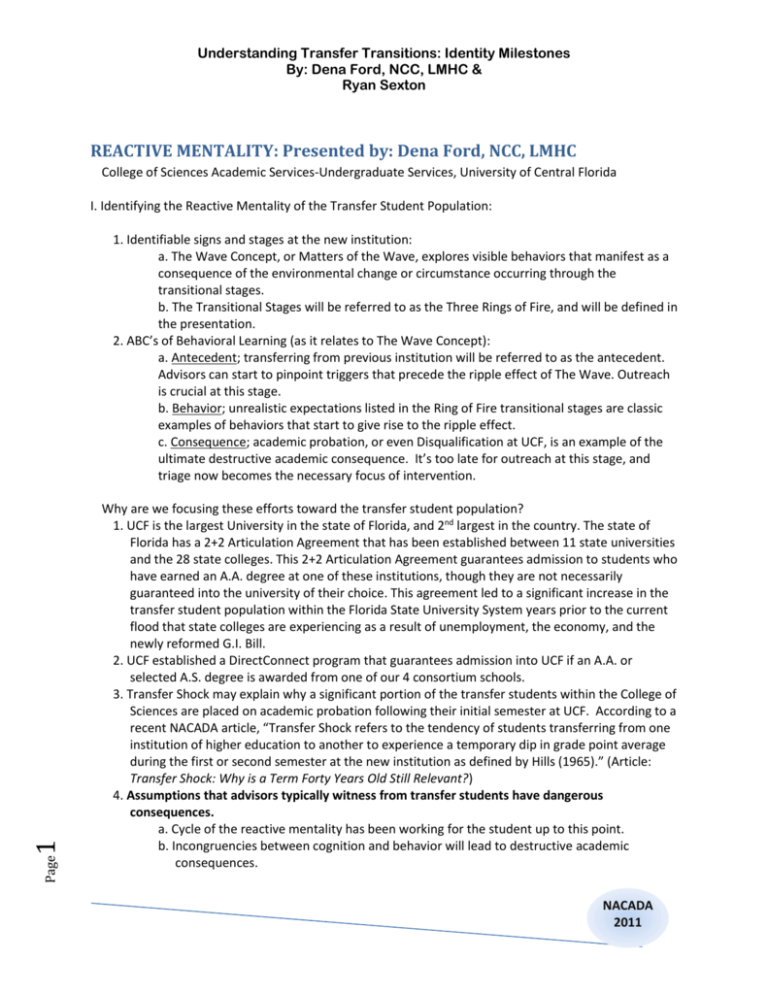
Understanding Transfer Transitions: Identity Milestones By: Dena Ford, NCC, LMHC & Ryan Sexton REACTIVE MENTALITY: Presented by: Dena Ford, NCC, LMHC College of Sciences Academic Services-Undergraduate Services, University of Central Florida I. Identifying the Reactive Mentality of the Transfer Student Population: Page 1 1. Identifiable signs and stages at the new institution: a. The Wave Concept, or Matters of the Wave, explores visible behaviors that manifest as a consequence of the environmental change or circumstance occurring through the transitional stages. b. The Transitional Stages will be referred to as the Three Rings of Fire, and will be defined in the presentation. 2. ABC’s of Behavioral Learning (as it relates to The Wave Concept): a. Antecedent; transferring from previous institution will be referred to as the antecedent. Advisors can start to pinpoint triggers that precede the ripple effect of The Wave. Outreach is crucial at this stage. b. Behavior; unrealistic expectations listed in the Ring of Fire transitional stages are classic examples of behaviors that start to give rise to the ripple effect. c. Consequence; academic probation, or even Disqualification at UCF, is an example of the ultimate destructive academic consequence. It’s too late for outreach at this stage, and triage now becomes the necessary focus of intervention. Why are we focusing these efforts toward the transfer student population? 1. UCF is the largest University in the state of Florida, and 2nd largest in the country. The state of Florida has a 2+2 Articulation Agreement that has been established between 11 state universities and the 28 state colleges. This 2+2 Articulation Agreement guarantees admission to students who have earned an A.A. degree at one of these institutions, though they are not necessarily guaranteed into the university of their choice. This agreement led to a significant increase in the transfer student population within the Florida State University System years prior to the current flood that state colleges are experiencing as a result of unemployment, the economy, and the newly reformed G.I. Bill. 2. UCF established a DirectConnect program that guarantees admission into UCF if an A.A. or selected A.S. degree is awarded from one of our 4 consortium schools. 3. Transfer Shock may explain why a significant portion of the transfer students within the College of Sciences are placed on academic probation following their initial semester at UCF. According to a recent NACADA article, “Transfer Shock refers to the tendency of students transferring from one institution of higher education to another to experience a temporary dip in grade point average during the first or second semester at the new institution as defined by Hills (1965).” (Article: Transfer Shock: Why is a Term Forty Years Old Still Relevant?) 4. Assumptions that advisors typically witness from transfer students have dangerous consequences. a. Cycle of the reactive mentality has been working for the student up to this point. b. Incongruencies between cognition and behavior will lead to destructive academic consequences. NACADA 2011 Understanding Transfer Transitions: Identity Milestones By: Dena Ford, NCC, LMHC & Ryan Sexton Expectations of the Institution: 1. Advisors at the College level can help shift transfer students away from the dangerous assumptions, or unrealistic expectations. 2. Institutions can offer resources and professional guidance to encourage a shift of the transfer student’s perspective toward realistic identifications with the new environment. a. The Three Rings of Fire transitional stages will be discussed in the presentation. b. The use of appreciative advising techniques is crucial as transfer students begin to identify with their chosen field/career. PROACTIVE SHIFT: Presented by: Ryan Sexton, Transfer and Transition Services at University of Central Florida 1. Shifts in Prospective a. Transfer students are no longer considered to be a minority group that can easily be ignored. Many universities, including UCF, are experiencing enrollment growth through their transfer students. Freshmen enrollment numbers have remained relatively static for quite some time. UCF admitted over 10,000 transfer students for the 2010-2011 school year, and total transfer enrollment for the fall 2011 term alone was 6,300 with 5,500 transferring from Florida state schools. b. The state of Florida has a statewide articulation agreement called the “2+2” program. i. Guaranteed admission to one of the 11 state universities though not necessarily the one of their choice. ii. Common Course numbering shares similar course descriptions though it is not a mandate to have similar syllabi. This has worked very well. iii. www.FACTS.org details the state wide Articulation Agreements. Middle school and high school students in Florida are required to use this resource with their guidance counselors. c. UCF has established partnerships via DirectConnect with Seminole, Lake Sumter, Valencia, and Brevard state colleges because these are UCF’s largest feeder schools. DirectConnect guarantees admission to UCF upon completion of A.A. degree or articulated A.S. degrees. i. Biggest issue even with UCF presence is that students are not picking a major early enough and are coming to UCF with few, if any prerequisites met. Page 2 II. Proactive measures that are in current use to help students identify milestones in hopes of preventing reactive measures. NACADA 2011 Page 3 Understanding Transfer Transitions: Identity Milestones By: Dena Ford, NCC, LMHC & Ryan Sexton 1. Deferred students typically are our highest risk student population academically and can lead to problematic transfer orientation outcomes. 2. Not being prepared with a targeted major can also lead to issues with excess credit fees. d. Outreach efforts have been increased as well as cross-institutional communications. 2. Transfer and Transition Services pre-admission proactive measures a. TTS has added an advising position on Valencia east campus to spearhead proactive preadmission advising and outreach efforts. Regional campuses also have advisors, though with Valencia east having over 18,000+ students, UCF’s presence is needed on this campus due to high transfer rate to UCF. Note: Valencia east is not regional campus. b. Typically there are 32 hours a week of advising appointments that offer a mix of walk-in advising and appointment advising. c. In efforts to reach as many students as possible, ‘Skillshops’ are hosted through fall and spring semesters. Many focus on the importance of choosing their major early and completing major prerequisites prior to their arrival at UCF. i. These efforts also focus on changes of academic environment such as class sizes, time commitments and academic rigor. d. TTS has partnered with many of the larger colleges and departments, especially the College of Sciences, UCF’s largest college, to co-facilitate Skillshops. i. The objective of bringing in staff from these departments and colleges is to allow students to ask in depth questions that the TTS office simply cannot answer. TTS also tries to connect students early to UCF and start educating potential transfer students on college expectations, requirements and resources. e. Transfer Advising Counselor Workshop offers an opportunity for state college advisors to connect with UCF advisors. i. TTS partners with Financial Aid, all UCF Colleges, and important departments to connect with our community college partners, especially our DirectConnect partners. ii. This Workshop generates approximately 100 community and state college advisors and staff attendance on UCF’s main campus per year, and this number increases each year. iii. A targeted goal of this Workshop is to inform and educate on policy changes and challenges transfer students face after they transfer, such as not having decided on a major and lacking prerequisites. This forum also offers UCF advisors the opportunity to stress important advising issues that require collaboration between institutions. 3. Transfer Student Orientation a. Facilitated each semester with the last two being dedicated mostly to deferred students. NACADA 2011 Understanding Transfer Transitions: Identity Milestones By: Dena Ford, NCC, LMHC & Ryan Sexton i. Deferred students are those students who were considered to be at high risk to not graduate from their community or state college, due to factors such as lower than a 2.5 overall GPA or are currently in their last math or English class. b. TTS works with the Office of First Year Experience, the UCF Colleges, and other departments to facilitate orientation. i. TTS goes over important policies and procedures as well as the increased academic expectations. ii. Various departments such as Experiential Learning, Student Accounts, Financial Aid, Student Academic Resource Center (SARC), and the Office of Student Involvement also speak to help educate and connect students to resources. iii. Colleges have the opportunity to provide academic advising to review College policy, procedures, and expectations. Degree audit, course scheduling, and prerequisites are a few items that the Colleges review during this initial advising session. c. Lunch is provided to transfer students followed by a scheduled registration session where multiple advisors are available. d. TTS also has some staff stationed in the ballroom and the main office for students who are lost, have general questions, to speak with parents, or for students who wish to discuss changing their major and the effects of that change. 4. Changes to Deferred Student Orientation a. A new shift to a virtual University overview followed by a face-to-face College-specific advising class was implemented this fall term, and this new shift is being considered for use at ALL transfer orientations due to some stats showing lower rate of probation for those that initially competed the virtual orientation. i. Must pass assessments ii. Leaves more time for face-to-face advisor contact iii. This is in progress and the first two were very successful iv. An assessment to shift all transfer orientations to this new set up is in consideration Reference: Page 4 Thurmond, K.C. (2007). Transfer Shock: Why is a Term Forty Years Old Still Relevant? Retrieved from NACADA Clearinghouse of Academic Advising Resources Web site: http://www.nacada.ksu.edu/Clearinghouse/AdvisingIssues/Transfer-Shock.htm NACADA 2011


